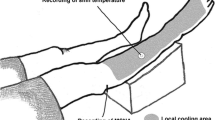Abstract
Skin sympathetic nerve activity (SSNA) controls skin blood flow and sweat release, and acute noxious stimulation of skin has been shown to cause a decrease in SSNA in the anaesthetised or spinal cat. In awake human subjects, acute muscle pain causes a transient rise in SSNA, but the impact of long-lasting (tonic) stimulation of muscle nociceptors on skin sympathetic outflow, blood flow and sweat release is unknown. We tested the hypothesis that tonic stimulation of muscle nociceptors causes a sustained increase in sympathetic outflow to the skin. SSNA was recorded from the common peroneal nerve of 10 awake human subjects. Tonic muscle pain was induced by infusing hypertonic saline (7 %) into the tibialis anterior muscle over ~40 min, titrated to achieve a constant level of muscle pain. SSNA initially increased following the onset of the infusion, reaching a peak of 164 % of baseline within 5 min, but then showed a prolonged and sustained decrease, reaching a nadir of 77 % in 20 min. Conversely, skin blood flow (and vascular conductance) initially decreased, followed by a progressive increase; there were no consistent changes in sweat release. In 9 of 10 subjects, SSNA and skin blood flow were inversely related. We conclude that sympathetic outflow to the skin exhibits a biphasic response to long-lasting stimulation of muscle nociceptors: an initial increase presumably related to the ‘arousal’ or ‘alerting’ component of pain, characterised by increased SSNA and decreased skin blood flow, followed by a prolonged decrease in SSNA and increased skin blood flow. The latter may be a purposeful response that contributes to wound healing.




Similar content being viewed by others
References
Bini G, Hagbarth KE, Hynninen P, Wallin BG (1980a) Regional similarities and differences in thermoregulatory vaso- and sudomotor tone. J Physiol 306:553–565
Bini G, Hagbarth KE, Hynninen P, Wallin BG (1980b) Thermoregulatory and rhythm-generating mechanisms governing the sudomotor and vasoconstrictor outflow in human cutaneous nerves. J Physiol 306:537–552
Burton AR, Brown R, Macefield VG (2008) Selective activation of muscle and skin nociceptors does not trigger exaggerated sympathetic responses in spinal-injured subjects. Spinal Cord 46:660–665
Burton AR, Birznieks I, Bolton PS, Henderson LA, Macefield VG (2009a) Effects of deep and superficial experimentally induced acute pain on muscle sympathetic nerve activity in human subjects. J Physiol 587:183–193
Burton AR, Birznieks I, Spaak J, Henderson LA, Macefield VG (2009b) Effects of deep and superficial experimentally induced acute pain on skin sympathetic nerve activity in human subjects. Exp Brain Res 195:317–324
Capra NF, Ro JY (2004) Human and animal experimental models of acute and chronic muscle pain: intramuscular algesic injection. Pain 110:3–7
Casale R, Elam M (1992) Normal sympathetic nerve activity in a reflex sympathetic dystrophy with marked skin vasoconstriction. J Autonom Nerv Sys 41:215–219
Delius W, Hagbarth KE, Hongell A, Wallin BG (1972) Manoeuvres affecting sympathetic outflow in human skin nerves. Acta Physiol Scand 84:177–186
Depaulis A, Keay KA, Bandler R (1992) Longitudinal neuronal organization of defensive reactions in the midbrain periaqueductal gray region of the rat. Exp Brain Res 90:307–318
Fazalbhoy A, Birznieks I, Macefield VG (2012) Individual differences in the cardiovascular responses to tonic muscle pain: parallel increases or decreases in muscle sympathetic nerve activity, blood pressure, and heart rate. Exp Physiol (in press)
Feinstein B, Langton JN, jameson RM, Schiller F (1954) Experiments on pain referred from deep somatic tissues. J Bone Joint Surg Am 36-A:981–997
Hagbarth KE, Hallin RG, Hongell A, Torebjörk HE, Wallin BG (1972) General characteristics of sympathetic activity in human skin nerves. Acta Physiol Scand 84:164–176
Horeyseck G, Jänig W (1974a) Reflexes in postganglionic fibres within skin and muscle nerves after noxious stimulation of skin. Exp Brain Res 20:125–134
Horeyseck G, Jänig W (1974b) Reflex activity in postganglionic fibres within skin and muscle nerves elicited by somatic stimuli in chronic spinal cats. Exp Brain Res 21:155–168
Ito H, Sugiyama Y, Mano T, Okada H, Matsukawa T, Iwase S (1996) Skin sympathetic nerve activity and event-related potentials during auditory oddball paradigms. J Auton Nerv Syst 60:129–135
Keay KA, Bandler R (1993) Deep and superficial noxious stimulation increases Fos-like immunoreactivity in different regions of the midbrain periaqueductal grey of the rat. Neurosci Lett 154:23–26
Keay KA, Clement CI, Owler B, Depaulis A, Bandler R (1994) Convergence of deep somatic and visceral nociceptive information onto a discrete ventrolateral midbrain periaqueductal gray region. Neuroscience 61:727–732
Kellogg DL Jr (2006) In vivo mechanisms of cutaneous vasodilation and vasoconstriction in humans during thermoregulatory challenges. J Appl Physiol 100:1709–1718
Kellogg DL Jr, Pérgola PE, Piest KL, Kosiba WA, Crandall CG, Grossmann M, Johnson JM (1995) Cutaneous active vasodilation in humans is mediated by cholinergic nerve cotransmission. Circ Res 77:1222–1228
Lewis T (1942) Pain. McMillan, London
Macefield VG, Wallin BG (1995) Effects of static lung inflation on sympathetic activity in human muscle nerves at rest and during asphyxia. J Autonom Nerv Syst 53:148–156
Macefield VG, Wallin BG (1999) Respiratory and cardiac modulation of single vasoconstrictor and sudomotor neurones to human skin. J Physiol 516:303–314
Roddie IC (1983) Circulation to skin and adipose tissue. In: Shepherd JT, Abboud FM (eds) Handbook of physiology, section 2: the cardiovascular system: peripheral circulation and organ blood flow, part 1, vol 3. American Physiological Society, Bethesda, pp 285–317
Sugenoya J, Iwase S, Mano T, Sugiyama Y, Ogawa T, Nishiyama T, Nishimura N, Kimura T (1998) Vasodilator component in sympathetic nerve activity destined for the skin of the dorsal foot of mildly heated humans. J Physiol 507:603–610
Acknowledgments
This work was supported by the National Health and Medical Research Council of Australia (Project Grant 1029782).
Author information
Authors and Affiliations
Corresponding author
Rights and permissions
About this article
Cite this article
Hall, S.C., Fazalbhoy, A., Birznieks, I. et al. Biphasic effects of tonic stimulation of muscle nociceptors on skin sympathetic nerve activity in human subjects. Exp Brain Res 221, 107–114 (2012). https://doi.org/10.1007/s00221-012-3156-y
Received:
Accepted:
Published:
Issue Date:
DOI: https://doi.org/10.1007/s00221-012-3156-y




